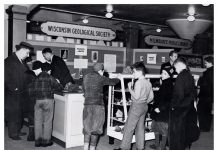
Gold panning in Georgia? When we think about gold panning, we don’t think of Georgia first. But in the United States, gold was first discovered in the Eastern states and it’s a great place for a family rock-hounding road trip.
There are reports of mined gold in Georgia by the Spanish and French explorers from 1560 to 1690, and Thomas Jefferson first referenced a gold discovery in Virginia in 1782. In 1799, gold was discovered in North Carolina. Gold was found in Dahlonega, Georgia, in 1828 and one year later in Maryland. Gold was found in Maryland within quartz veins, together with pyrite and/or galena, mostly near the Great Falls of Potomac (Maryland Gold Fever, Walter A. Goetz, 1979, revised 1996). Maryland state became the northern end of the “Appalachian Gold Belt.”
Dahlonega, Georgia

The Dahlonega Gold Museum Historic Site is housed in the 1836 Old Lumpkin County Courthouse. The museum’s exhibits share the history of the 1828 gold discovery, two and a half miles south of Dahlonega by deer hunter Benjamin Parks. That discovery triggered America’s first major gold rush in northwest Georgia, where thousands of prospectors poured into the Cherokee Nation area within the next year. The intruding miners did not respect the Cherokee lands and agreements with the Federal government and caused a lot of problems and lawlessness.
The town of Dahlonega was established in 1832. After the 1835 treaty that the United States made with the Cherokees, whereby the Cherokee agreed to give up their lands for $5,000.000 and migrate west of the Mississippi to what is now Oklahoma, the town of Dahlonega and the gold miners thrived.

All photos courtesy Helen Serras-Herman
A U.S. Mint opened in Dahlonega in 1838, coining more than $6 million in gold before closing in 1861. One of the museum’s amazing exhibits is a complete set of those rare gold coins on loan from the North Georgia College and State University. Also on exhibit is a gold pan with approximately five ounces of gold dust and nuggets found by a local prospector in 1996, surrounded by gold nuggets and gold ore specimens from the Loud Mine in White County, Battle Branch Mine in Auraria, Crown Mountain Mine in Dahlonega, and the Calhoun Mine in Lumpkin County – the site of the first discovery of vein gold. The Calhoun Mine got its name because it was purchased shortly after the gold discovery by U.S. Senator John C. Calhoun of South Carolina, and his son-in-law, Thomas G. Clemson, operated the mine.
Several rooms in the Dahlonega Gold Museum and exhibits, artifacts, and mining equipment tell the story of the gold discovery and Georgia’s nearly 200-year-old mining history. A 25-minute film describes the mining techniques, hardships and lifestyle of the gold prospectors.
Consolidated Gold Mine

The Consolidated Gold Mine offers a 45-minute Underground Adventure Tour that takes visitors 200 feet underground. The guides share tales of miners’ struggles and show the equipment used for underground mining. The mine operated from 1900 to 1906 and was probably the largest gold plant east of the Mississippi. It had a 120-stamp mill, a large chlorinator, a 500-foot tunnel, and numerous small buildings. The $18 tour admission includes a gold-panning sample with a gold-panning demonstration. The mine is located at 185 Consolidated Mine Road and is open seven days a week.
Crisson Gold Mine
The Crisson Gold Mine is an open-pit gold mine, established in 1847. It was commercially explored until the 1980s. The mine started as a tunnel mining operation, with some hydraulic mining machinery in use. Once the old tunnels were dugout, it resulted in a new open-pit mining operation, which continues today.

The mine’s instructors are happy and willing to teach everyone how to pan for gold. On-site is a crusher from the late 1800s – a ten-stamp mill, with each stamp weighing 450 pounds each, still used today to crush the gold-bearing quartz rock into sand. In addition, the mine has rod mills and jaw crushers which they use upon occasion. The guides take visitors to see the Stamp Mill, which is the only working stamp mill in the state of Georgia and only one of two in the Southeast.
The gold-panning experience at the Crisson Gold Mine includes several options. Visitors can purchase five-gallon buckets with concentrated ore and pan by hand or rent the trommel to run the dirt through it before the final panning.
Concentrated gold ore can be purchased to pan at home, especially during the winter months. The mining shop has a lot of gold mining equipment, including pans, dredges, and metal detectors.
The Crisson Mine is located at 2736 Morrison Moore Pkwy, E. Dahlonega, and is open seven days a week.
This story about gold panning in Georgia previously appeared in Rock & Gem magazine. Click here to subscribe! Story by Helen Serras-Herman.














